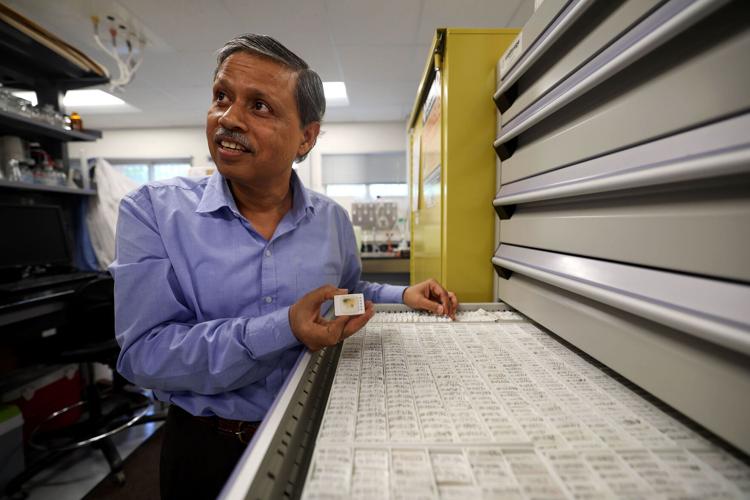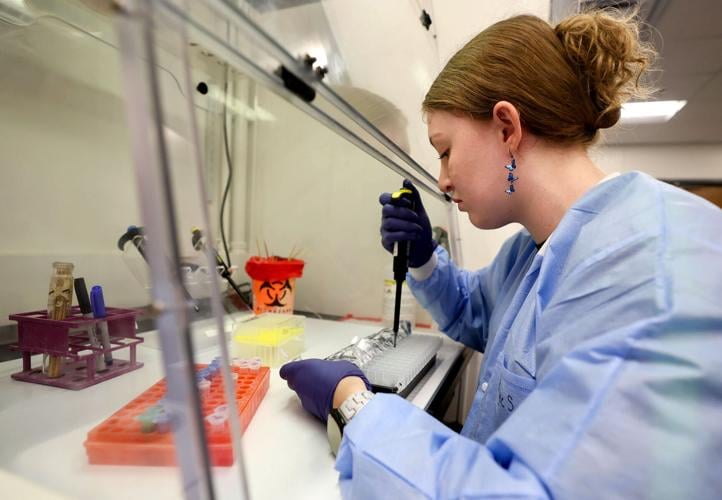The University of Arizona innovation machine keeps churning out inventions and pushing them to market.
Tech Launch Arizona, the UA office that commercializes technology stemming from university research, reported a record number of invention disclosures from faculty members during the 2024 fiscal year.
During the fiscal year ended June 30, TLA received 307 new invention disclosures, up from 298 in fiscal year 2023 and 303 in fiscal 2022.

Arun Dhar, the founder of AQvac and director of the University of Arizona Aquaculture Pathology Lab, shows a collection of samples taken from shrimp on Aug. 21.
The office also launched nine startups, up from seven the prior fiscal year; executed 75 licenses and options for UA inventions; filed for 367 patents; and received 78 new patents.
It was a good year for TLA, which celebrated its 10th anniversary in 2022.
And it’s off to a good start to the current fiscal year, as TLA-backed UA startup NeuroID, which developed a system to detect online fraud through behavior analysis based on the work of a UA faculty member, was recently acquired by credit-reporting giant Experian.
The rising number of invention disclosures — in which faculty members disclose patentable inventions — is especially important given they are the raw material for TLA.
“That’s the beginning of the pipeline for us,” said Doug Hockstad, associate vice president of Tech Launch Arizona. “This represents a new record for the university, shows continued growth and means that our pipeline is strong.”
Hockstad, who has led TLA since 2018, said outreach events to educate faculty members about the UA’s technology commercialization process dropped off a bit in the wake of the COVID-19 pandemic.
Faculty ambassadors
Tech Launch Arizona is looking to boost invention disclosures with new “Faculty Innovation Ambassadors” — key faculty members with experience in tech commercialization — named in May from each of the eight UA colleges that have typically produced larger numbers of inventions.
Those include the James C. Wyant College of Optical Sciences; the College of Medicine in both Tucson and Phoenix; College of Science; College of Agriculture, Life & Environmental Sciences; College of Pharmacy; Eller College of Management; and the College of Engineering.
Hockstad said the ambassador program grew out of discussions held over the past year by a working group comprised of tech-transfer managers from the UA, Vanderbilt University, Duke University, the University of Michigan and Baylor University.
The faculty ambassadors will serve as sources of information about inventions, licensing and startups for their colleagues and students, and TLA has planned a series of events in the fall to introduce them to their college communities.
The eight initial faculty ambassadors have all either been involved in startups or licensing deals involving technologies developed at the UA, Hockstad said.
“They’re just rock star inventors and entrepreneurs, and have been great partners for us,” Hockstad said.
One example is the inaugural ambassador for the Eller College, Management Information Systems professor Joseph Valacich, inventor and co-founder of NeuroID, which was acquired by Experian in mid-August.
In May, TLA launched the Startup Hub, a website designed to connect high-tech entrepreneurs with promising UA inventions and startups.
The hub lists an initial 10 startup opportunities for experienced entrepreneurs to come in as co-founders and CEOs to help bring technologies from the UA’s world-class labs to market.
One recent example on the list is AQVac LLC, which was co-founded earlier this year to commercialize technology developed in the UA’s world-renowned Aquaculture Pathology Laboratory to help create oral vaccines for shrimp and other crustaceans and fish.
Shrimp, fish vaccine

Kaylee Stein, a PCR technician, collects samples inside of the University of Arizona Aquaculture Pathology Lab.
The lab became a leader in technologies to identify and prevent diseases in the $70 billion global shrimp market under the late UA professor Doug Lightner, who founded the lab in the 1980s and discovered the cause of a lethal disease that devastated shrimp farms worldwide in the mid-2010s.
UA professor Arun Dhar, current director of the aquaculture lab and AQVac co-founder, said the new technology uses molecular-level diagnostic testing used for human testing, polymerase chain reaction or PCR, to detect and quantify DNA and RNA viruses infecting marine shrimp.
The self-funded lab, which serves as a reference lab for the World Organization for Animal Health, already conducts high-level genetic testing for the world-leading U.S. aquaculture breeding industry, as well as performing testing and training for shrimp producers and industry and government professionals worldwide, Dhar noted.
The technology could help scientists develop gene-based vaccines that can administered in animal feed as a preventative measure, or create new treatments for not only shrimp, but for fish as well, said Dhar, who became head of the UA lab in 2017.
“We’re developing a generic platform that would enable you to put your vaccine in and mix it with the diet and the fish or shrimp will be able to protect themselves,” Dhar said, noting that some salmon and trout fish-farming operations actually inject vaccines into fish by hand to ward off diseases.
With TLA’s help, Dhar filed for a patent on key technology he developed using insect cells to carry genetic material, along with related patents, said Dhar, a Ph.D. in plant virology who already holds multiple patents from his prior work.
AQVac, co-founded by Ph.D. biologist Thomas Allnutt, is not conducting research at the UA lab and plans to open its own laboratory down the road, Dhar said.
Forging student success
TLA also is developing new programs aimed at boosting student entrepreneurs.
In July, the UA announced that resources formerly managed by its Arizona FORGE entrepreneurship center downtown at Roy Place would be taken up by Tech Launch Arizona to provide new programs to advance student entrepreneurship.
FORGE was in operation for six years and included basic startup education for students, mentoring, a business growth accelerator and a program for Native American entrepreneurs, Native FORGE.
(FORGE’s founding executive director, Brian Ellerman, is now executive director of a new accelerator program at the Phoenix Bioscience Core, a 30-acre life sciences “innovation district” in downtown Phoenix; Native FORGE’s programs have been taken up by the UA’s Native American Advancement, Initiatives & Research group on the main campus.)
TLA’s new Student Ventures program, branded as “Startup Wildcats,” is an effort to help student entrepreneurship with their own ideas or intellectual property, rather than those developed at and owned by the UA, and aren’t part of the UA’s highly ranked program at the McGuire Center for Entrepreneurship, said Paul Tumarkin, TLA assistant director for communications and marketing.
“They have lots of interests, but they want to dip their toe into this entrepreneurial world,” Tumarkin said. “Some of them might have already started businesses of their own, they’re selling something, or they’re consulting, or they have an invention idea, and they need resources to help them move that forward.”
Hockstad said that beyond education, the Student Ventures program is looking to match students to intern with local startups to gain firsthand experience, as well as help students grow ventures they may already have going.
The nascent Startup Wildcats got a financial boost in January, when the UA announced an anonymous, $1 million donation to its Wildcat Philanthropic Seed Fund, an early-stage fund meant to help support UA startups.
Hockstad said the fund, which will support early-stage startups based on UA tech as well as independent student ventures, is set up as a philanthropy, with donors getting tax deductions for their contributions.
The fund then invests that money, and any equity value created goes back into the fund to create a self-sustaining resource.
“We’re launching dozens of startups every year, and the hardest thing for them to do is raise their first little bit of money,” Hoskstad said, noting that the fund has now reached the $2 million goal it set before it began investing in amounts that will range generally from $25,000 to $250,000.
Social innovation
TLA continued to grow its National Science Foundation Innovation Corps, or NSF I-Corps, which helps increase the impact of federally funded research by preparing academic inventors to move their innovations from the lab to the marketplace.
Twenty-seven UA teams went through the program, and TLA leaders hope to surpass that number in 2025.
Last year, TLA had its first-ever I-Corps cohort dedicated to “social innovation” — research and projects directed at solving significant social challenges, such as poverty or issues related to health care, education and sustainability. Ten teams from three institutions in two states participated.
Examples include an idea for outdoor kiosks to educate people about sun safety and a company developing technology for sustainable hydrogen production.
But Hockstad said it has been hard to reach those who have ideas with potential positive social impact, since they don’t think of working with TLA.
“So we’re trying to figure out, how do we reach out to these people, understand what they’re working on, and figure out, ‘is there a model to get this out to the public?,’” he said. “And it doesn’t have to make money, it’s ‘how can we get it out to have a greater impact on the ecosystem?’”
By the numbers
Since its inception in 2012, TLA has registered more than 3,000 inventions, generated more than 600 patents and helped launch more than 140 startup companies.
From 2016 to 2021, TLA supported more than 2,500 jobs, and generated $1.6 billion impact on the Arizona economy, with that impact expected to grow to $4.7 billion by 2031, according to a 2022 study by Rounds Consulting.
Several companies nurtured by Tech Launch Arizona have been acquired in deals that resulted in profitable “exits” for early investors.
Besides NeuroID, TLA-aided UA startups that have been acquired in recent years include Avirtek Inc., which was based on UA-developed technology for adaptive, autonomous cybersecurity systems; Cancer Prevention Pharmaceuticals; and GenetiRate, which commercialized a technology to sort farmed fish by their metabolic rates to increase production.
TLA also has boosted its revenue from licensing patented UA technologies to startups as well as established companies.
In fiscal 2023, TLA reported gross license income of nearly $10.5 million, rising slightly from fiscal 2022 and up from about $8.6 million in 2021.
By comparison, Arizona State University had fiscal 2023 license revenue of about $694,000, according to annual data compiled by the Association of University Technology Managers.
Such revenue is divided among the inventors and in some cases their departments, with some money going to fund TLA’s efforts.
Terms of the sale of NeuroID were not disclosed, but TLA held warrants to buy stock in the company, which it can now cash in, and Experian has effectively assumed the licenses for the UA-owned technology.
Meanwhile, the UA has been getting more of the research money that fuels its innovation machine.
Research spending nears $1B
In fiscal 2022, the UA ranked 20th among U.S. public universities for overall research spending at $824.3 million, just ahead of Arizona State University at $797 million, according to the most recent comparative data compiled by the National Science Foundation.
In fiscal year 2023, the UA’s total research spending jumped to $955 million, and it could near the $1 billion mark when the final figures come in for the recently ended fiscal 2024, Elliott Cheu, UA interim vice president for research and innovation said at a recent event at the UA Tech Park.
Most of the funding comes from federal research grants, with about 30% coming from the UA, which gets funding from state sales taxes through the Technology Research Initiative Fund, or TRIF, Cheu noted.
In fiscal 2023, the UA spent $26.4 million in TRIF funding mainly to advance projects in health care, national security and space exploration, according to the Arizona Board of Regents’ most recent TRIF report.





